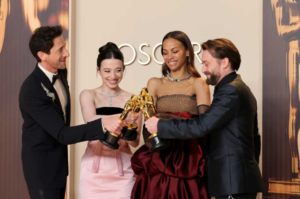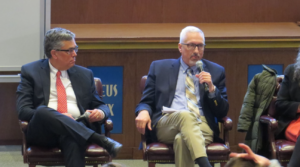Review: The Mariinsky Ballet’s Paquita at the Kennedy Center

Courtesy of The Kennedy Center
By Jacqueline Jedrych
The Mariinsky Ballet, considered one of the foremost ballet companies in the world, is returning this year to the Kennedy Center to perform Paquita. The ballet is rarely performed in its entirety for contemporary audiences, both because of its archaic plot and sheer length. The show finished its week-long run on October 13th.
Performing Paquita is quite a feat, clocking in at three acts of nearly three hours. The first two acts chronicle the story of lost royalty and young love, while the third act, which tells the story of Paquita and Andrés’ wedding, has six solo Grand Pas variations.
Stolen from her noble parents as a baby, Paquita travels with her family of dancers to a new village. Paquita, danced by first soloist Maria Khoreva, is spunky and strong-willed; Khoreva embodies this adeptly. Her extensions alone earned amazed gasps from the audience, but the climax of her performance was a string of nearly 30 fouettés, interspersed with double and triple turns. Khoreva showed remarkable stability and strength throughout her performance.
The vibrant clan of villagers danced in low-heeled character shoes and costumes adorned with jingling gold chains. The group was draped in swathes of brightly colored fabric that swirled as they danced in near-perfect unison. The soldiers’ capes were lined with bright red fabric, which provided a pop of color when the performers whipped them around their partners.
One audience favorite was the pantomime horse– two company members under a sheet with a horse head precariously perched on the front. Even under the costume, their jumps were precise and synchronized, scoring the loudest laughter of the night from the audience. Another highlight of the show was the appearance of students at the Vaganova school. The audience oohed and ahhed at the crisply costumed ten-year-olds as they waltzed around the stage with enviable precision.
Everyone in the village admired the talent of the beautiful Paquita which garnered her many suitors, but her eye fell on the young soldier Andrés. First soloist, Konstantin Zverev, danced Andrés, soaring feet above the stage with aristocratic exuberance. Zverev served as an excellent complement to Khoreva’s precise movements. Their obvious chemistry made Paquita and Andrés’ relationship come to life on the stage.
Paquita fell for Andrés and he joined her group of travelers. However, when they tried to leave, Andrés’ scorned admirer Carducha framed him for theft. A fight breaks out where Andrés mortally wounded a soldier who attacked him. Paquita defended him and they were both subsequently thrown in jail, where they dance a poignant pas de deux. The dimmed lighting and mournful score heightened the sense of despair that encircled the couple.
During the fight, Paquita’s real father sees the medallion given to Paquita at birth in the traveler’s wagon and realizes she is his lost daughter. He goes to the jail and frees Paquita and Andrés, who get married.
The third act was their wedding celebration. Paquita and Andrés danced together for a short pas de deux, but the bulk of the scene is the Grand Pas variations. The third act is often performed by itself, in the past being used as the graduation recital of the Vaganova academy. It has virtually no plot function, but it features six solo variations, making it ideal for a recital. Some variations hail from other ballets, such as King Candaules, Le Corsaire, and Camargo. These were first danced by celebrated dancers like Anna Pavlova, Alexandra Shaposhnikov, Maria Gorshenkova, and Anna Johansson. The soloists danced with grace, the corps framed each scene like a storybook, and the costumes and sets brought the audience into a fairytale world. The Mariinsky Ballet’s annual return to the Kennedy Center never disappoints, but this year’s production of Paquita brought the audience to their feet for a four-minute standing ovation.








